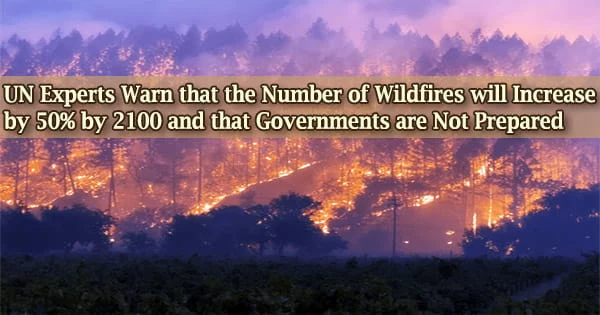According to a new analysis by the UN Environment Programme (UNEP) and GRID-Arendal, climate change and land-use change are anticipated to increase wildfire frequency and intensity, with a global increase in extreme flames of up to 14% by 2030, 30% by the end of 2050, and 50% by the end of the century.
In order to avoid and prepare for wildfires, the study advocates for a fundamental shift in how much money the government spends on them.
Even the Arctic and other formerly unaffected places now face a higher danger of extraordinary landscape fires, according to the research Spreading like Wildfire: The Rising Threat of Extraordinary Landscape Fires.
The UN Environment Assembly’s 5th session, which will be held in Nairobi between February 28 and March 2, 2022, will resume with the publishing of the report.
Governments are urged to implement a new “Fire Ready Formula” in which two thirds of spending would go toward planning, prevention, preparedness, and recovery, with the remaining third going toward reaction.
Currently, planning and prevention only account for 1% of associated spending, whereas direct responses to wildfires generally garner over 50%. The authors recommend a mix of data- and science-based monitoring systems with indigenous knowledge, as well as increased regional and global cooperation, to avert fires.
The way the government is now responding to wildfires frequently wastes money. Support must be given to those emergency service personnel and firefighters who risk their lives to battle forest wildfires.
“We have to minimize the risk of extreme wildfires by being better prepared: invest more in fire risk reduction, work with local communities, and strengthen global commitment to fight climate change,” said Inger Andersen, UNEP Executive Director.
The poorest countries on earth are disproportionately affected by wildfires. After the flames go out, their effects can last for days, weeks, or even years, which makes it difficult to achieve the UN Sustainable Development Goals and worsens social inequality:
- Wildfire smoke directly affects people’s health, having a greater negative influence on the most vulnerable people’s respiratory and cardiovascular systems;
- Low-income nations may not be able to afford the financial demands of rebuilding after wildfires have destroyed areas;
- Wildfires pollute watersheds, and they can also cause soil erosion, which worsens the difficulties for streams;
- Wastes left behind are often highly contaminated and require appropriate disposal.
We have to minimize the risk of extreme wildfires by being better prepared: invest more in fire risk reduction, work with local communities, and strengthen global commitment to fight climate change.
Inger Andersen
The effects of both wildfires and climate change are exacerbated. Climate change exacerbates wildfires by lengthening fire seasons and making them hotter, dryer, and more frequent due to increased drought, high air temperatures, low relative humidity, lightning, and strong winds.
Wildfires also exacerbate climate change, mostly by destroying delicate and carbon-rich ecosystems like peatlands and rainforests. This makes landscapes tinderboxes and makes it more difficult to stop the increase in temperature.
Wildfires rarely spare wildlife and its natural habitats, bringing certain animal and plant species closer to extinction. The Australian 2020 bushfires are one recent instance; it is predicted that billions of domesticated and wild animals perished in these fires.
An urgent need exists to comprehend wildfire behavior better. A mix of policies, a legal framework, and incentives that promote responsible land and fire use is necessary to achieve and maintain adaptive land and fire management.
Ecosystem restoration is a crucial strategy for reducing wildfire risk before they start and for rebuilding more effectively afterward.
Among the crucial investments in prevention, readiness, and recovery are the restoration of wetlands, the reintroduction of species like beavers, the preservation of open space buffers, building away from vegetation, and the repair of peatlands.
The research ends with a request for tougher international regulations to protect firefighters’ health and safety and to reduce the hazards they confront before, during, and after operations. This involves educating people about the dangers of smoke inhalation, reducing the likelihood of entrapments that could be fatal, and ensuring that firefighters have access to enough hydration, nutrition, rest, and recuperation time in between shifts.
The UN Decade on Ecosystem Restoration and UNREDD both received support from the report’s commission. In order to lower the risk of fire in vital ecosystems around the world, UNEP will investigate further financing opportunities.















